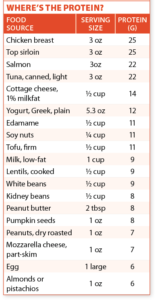Got Protein? Diet Tips to Benefit Your Bones, Muscles, and More
The best type of protein diet involves plant foods as well as animal foods in combination with whole or minimally processed foods.
You may have heard about a protein diet, but what is it, why are nutritionists not always on the same page?
Health experts do, in fact, have varying opinions on how much protein needs to be consumed for optimum health. However, one thing they all agree on is that eating protein every day is a dietary essential.
One primary function of protein is that it contributes to lean muscle mass. As you get older, your body naturally loses muscle mass, and the only way to maintain or increase muscle mass is to stay active and include enough protein in your diet.
Protein Diet: Bone Benefits
Another key role of protein involves bone health. A major component of bones is collagen, which is a form of protein. Also, if you don’t eat enough protein, it can contribute to decreased calcium absorption, which can cause bones to become weak and fragile.
“Proteins also form enzymes that you need to digest and absorb foods, as well as glycoproteins that help form collagen and elastin in your skin, and protein is needed for cell repair,” explains Jenna Rosenfeld, MS, RD, CDN, CNSC, a dietitian at NewYork-Presbyterian/Weill Cornell.
PROTEIN DIET ADVICE
- If you have 2 two scrambled eggs for breakfast, a chicken or tuna sandwich for lunch, and shrimp or scallops for dinner, you’ll consume about 48 grams of protein. Add a serving of yogurt or cottage cheese for a snack or drink milk with one of your meals to boost your protein intake higher.
- If you’re a vegetarian, have oatmeal with soymilk and almonds for breakfast, lentil or bean soup for lunch, a snack that includes peanut or almond butter, and tofu for dinner to get about 49 grams of protein. Add a handful of pumpkin seeds or a snack of vegetables with hummus to further increase your protein total.
Protein Diet Recommendations
The Recommended Dietary Allowance (RDA) for protein is 0.8 grams of protein per kilogram of body weight, or 0.36 grams per pound; that’s 47 grams for a person weighing 130 pounds and 54 grams for a person weighing 150 pounds. However, in recent years, researchers have found that older adults may need 1.0 to 1.2 grams of protein per kilogram, or 0.45 to 0.55 grams per pound, to support healthy aging.
You’ll also need to consume more protein if you’re very active or you engage in intensive strength training to ensure that your muscles get the fuel they need.
Don’t worry if you don’t get the exact number of recommended grams of protein per day; just make sure you’re including protein in all of your meals, especially at breakfast.
“The best way to ensure you’re meeting your protein needs is to consume some protein at every meal and snack,” says Rosenfeld. “Eating protein also helps keep you satisfied longer, so you’ll be less likely to get hungry before it’s time for your next snack or meal.”
If you think you may need to increase your protein intake, check with your doctor first to ensure that it’s safe; people with impaired kidney function should not eat high-protein diets because it can further compromise kidney health. And, diets that are high in protein and low in carbohydrates can cause constipation, gas, and bloating.
If your protein intake is too high, you may not be getting enough fat and carbohydrates, and your diet may lack vitamins, minerals, and nutrients contained in other healthy foods, including fruits, vegetables, and whole grains.
Sources of Protein: Diet Advice
While most people think of meat, poultry, and fish when they think about protein, remember that dairy foods, along with many plant-sourced foods, also provide protein.
Plant foods that are good sources of protein include legumes (beans, peas, and lentils), nuts, and seeds. Also, many grains contain some protein. Quinoa contains eight grams of protein per cup; whole wheat, oats, wild rice, corn meal, and other grains, as well as bread and pasta made from these grains, provide between two and five grams of protein per serving.
Protein-rich animal-sourced foods include dairy foods and eggs, which provide between six and 14 grams per serving, and meat, fish, and poultry, which provide between 20 and 26 grams of protein per serving.
Whether your protein is from a plant or an animal, the healthiest sources are unprocessed or minimally processed foods. For example, have a handful of unsalted nuts rather than a sweet or salty protein bar made with nuts, or have a tuna sandwich instead of bologna or processed cold cuts, advises Rosenfeld.
Plant Protein Provides Benefits
The “Western” dietary pattern that many Americans have followed for decades is much higher in animal proteins than in plant proteins. Research, however, has shown that eating more plant foods and fewer animal foods decreases the risks of heart disease, hypertension, type 2 diabetes, and obesity.
Many health experts now advise following a plant-based diet, which emphasizes plant foods but doesn’t necessarily exclude animal foods. Getting more protein from plants will boost your consumption of fiber, vitamins, minerals, and phytochemicals (health-protective plant compounds), and cutting back on animal foods will cut your intake of saturated fat and may reduce your calorie intake.



 Ask the EN Experts March 2025
Ask the EN Experts March 2025  Vegan Diet Better Than Omnivore Diet for Cardiovascular Health
Vegan Diet Better Than Omnivore Diet for Cardiovascular Health 
Typically, meats, cheese, and eggs come to mind first when we think "protein diet." Experts advise us, however, not to overlook plant-based sources of protein, including seeds and nuts.
© Nevinates | Dreamstime.com